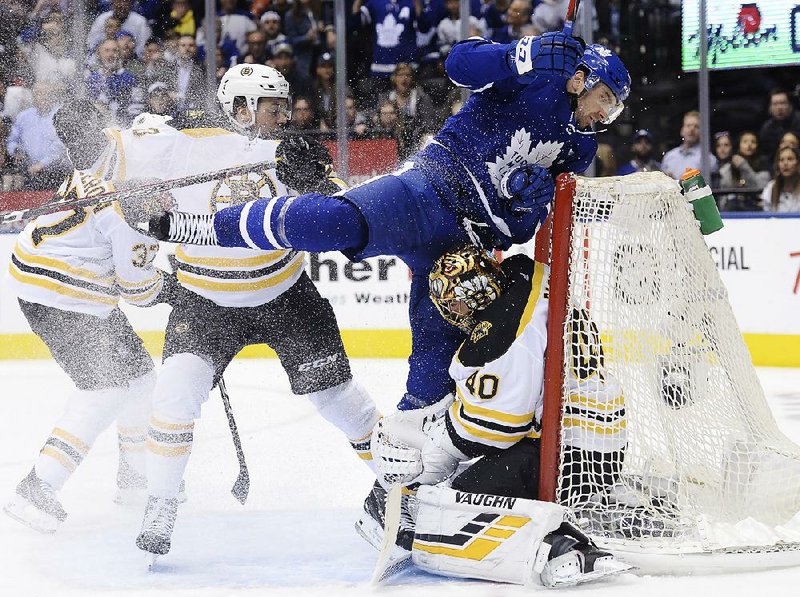Filip Chytil beat the last defender to the net, snapped the shot past Tuukka Rask and barreled over the goaltender he had just scored on.
Rask flipped his mask off, lay prone and needed assistance to get to his feet and to the Boston Bruins locker room. The goal counted and Chytil faced no repercussions.
Rask suffered a concussion.
“I think it’s brutal, but what can you do?” he said. “The game’s so fast nowadays and space is limited. The guy’s driving wide and the D’s half a step late, then collisions happen.”
Those kinds of collisions are happening at an alarming rate over the past couple of seasons and goaltenders are getting hurt. Just two goaltenders were concussed in 2016-17, missing a total of 15 games, but over the past two seasons, 14 different goalies missed a total of 276 games with a concussion or head injury caused by everything from elbows and knees to pucks off their helmets.
This is a jarring statistic involving the most important position in hockey, but the NHL has not yet taken further steps to protect its masked men. In recent years, the focus has been on trimming the size of goalie equipment as a way to generate more offense and players are routinely coached to crash the net whenever possible. It adds up to putting the most valuable and vulnerable players on the ice at risk of head contact they can do little to avoid and often isn’t even penalized.
“We’re so dialed in on the puck, a lot of times you don’t see guys come from the side,” New York Rangers goalie Henrik Lundqvist said. “As a player, you can always adjust your body, but if we adjust our positioning, we open up the net. You just have to stand there and I think in a lot of situations hope for the best when people come running into you.”
Hoping for the best isn’t exactly a reassuring strategy, but goalies say there is not much else they can do. Rask, who saw Chytil coming, said goalies mostly are at the mercy of their teammates, opponents and the officials.
“You’ve got to trust that your D-men are going to be there to help protect you and with the referees calling penalties and stuff with goaltender interference that they’re going to try and protect us, too,” said Anaheim Ducks starter John Gibson, who missed a combined 10 games with two separate concussions the last two years.
Goalies have different theories on why concussions and head injuries are up in recent years.
Ben Bishop of Dallas said he believes the overall decline in fighting correlates to the increase of players feeling like they can take liberties at the crease, while Washington’s Braden Holtby considers it part of how players are taught from a young age now.
Others point to the inconsistency of goaltender interference calls, which can be as lenient as waving off a goal with no penalty and as severe as a two-minute minor. Holtby and his peers say a minor penalty is not much of a deterrent to keep players from crashing the net in hopes of a goal.
“I think the league has to [change] the rule,” Tampa Bay’s Andrei Vasilevskiy said. “Maybe it’s a few-game suspension.”
The NHL in recent years has taken steps to reduce hits to the head. Rule 48 instituted in 2010 makes virtually any hit with contact to an opponent’s head a penalty, but Holtby said head contact to goalies is “not treated the same as everywhere else on the ice for some reason.”
Concussion spotters in 2016 were given the authority to remove a player from a game if he exhibits visible signs of a concussion, and that applies to goalies as well.
“You need to take responsibility on yourself to realize if something’s not right that you need to at least get checked out,” Gibson added. “With all the programs that they have now, maybe they miss it and you’re not feeling quite right, usually the trainer will come and ask you if you’re not OK or you feel something, and then there’s little tests you can go do in the back. And obviously if that doesn’t work, you’ve got to take some responsibility on yourself to say, ‘I’m not feeling quite right.’ ”
